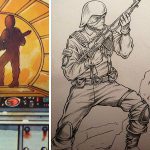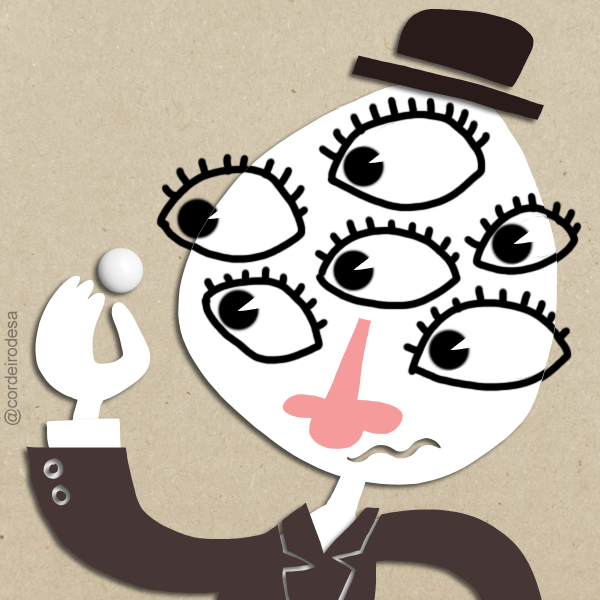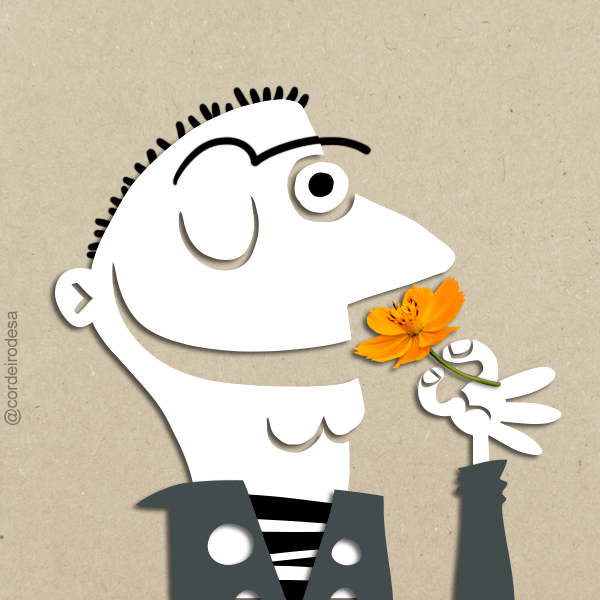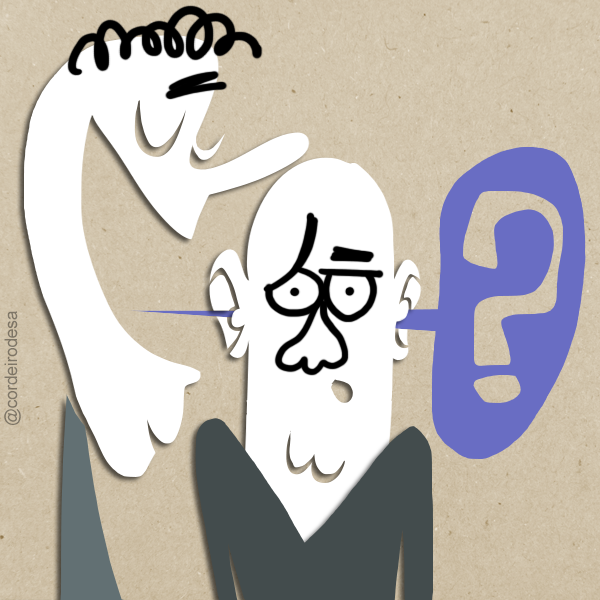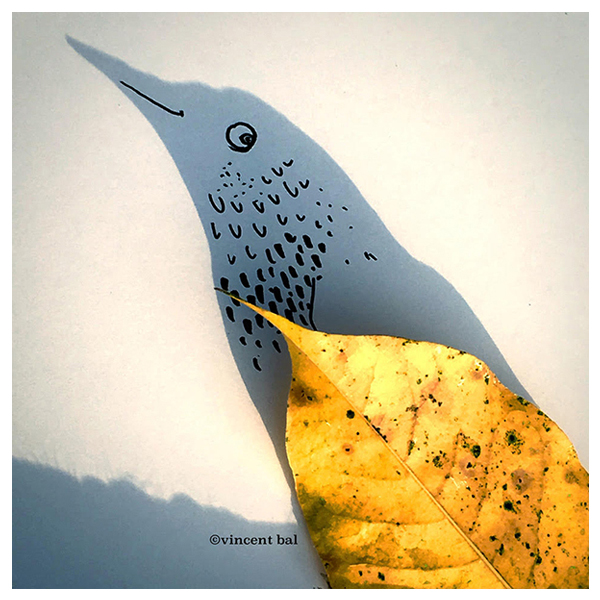
Entrevista: Vincent Bal, criatividade e sombras
Se você já viu o trabalho de Vincent Bal deve ter se maravilhado com seus “Shadow Doodles“. Se não, essa é uma boa oportunidade de conhecê-lo e de saber um pouco sobre o processo criativo desse respeitadíssimo ilustrador e filmmaker belga que, um dia, olhou de forma diferente para a sombra que uma xícara de chá projetou.
(Ok… nada que a Gestalt não tenha nos contado antes, mas as suas crias são um misto de singeleza e sagacidade único!)
Um amigo me marcou em uma de suas artes no Facebook e comecei a pesquisar mais, devorando tudo o que encontrava. Descobri seu contato, enviei uma mensagem e recebi a resposta logo no dia seguinte. Traduzi e agora partilho com você. Divirta-se!
Olá, Mr. Vincent Bal! (…) O senhor conta em algumas entrevistas que seu primeiro insight aconteceu por acaso, mas confesso que duvido desse “mero acidente”. Seria possível identificar elementos que o prepararam para aquele exato momento?
Hi, Cordeiro! (…) Eu estou sempre rabiscando. Quando estou em uma reunião, saio com papéis cheios de desenhos bobos. Além disso, adoro fazer fotos e adoro a imaginação – sem imaginação, o mundo seria um lugar tão chato… Então, de certa forma, tenho me preparado para esses desenhos toda a minha vida, mas por outro lado, acredito fortemente no poder das coincidências, “acidentes de sorte” para os quais você tem que estar preparado. É como ver formas nas nuvens, eu acho que você vê as formas das coisas que estão em sua mente.
Eu tento me levar a uma espécie de estado semi-desperto, onde fantasia e realidade estão próximas umas das outras. O bom de desenhar é que minhas mãos pensam. Eu trabalho em roteiros de vez em quando e, para isso, preciso pensar muito racional e estruturalmente.
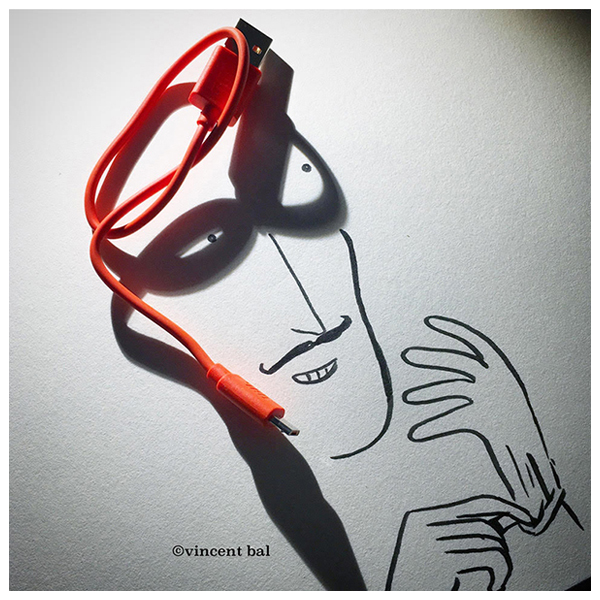
Meu maior interesse é entender seu processo criativo, mas sei que isso é difícil para o próprio artista, já que a criatividade não se limita ao campo consciente (…) Seja como ilustrador ou filmmaker, como poderia descrever a estrutura geral de seu método? Oque cultiva e o que despreza ao longo do caminho?
Para mim, é muito importante silenciar aquela voz irritante na minha cabeça que me diz: “isso não está bom!”.
Eu tenho que trabalhar com entusiasmo, tenho que me divertir e nestes desenhos isso não é tão difícil, porque é tudo muito gostoso e pessoal e toda a equipe é só eu e eu. Trabalhar em um filme é muito diferente, pode levar anos desde a ideia até o resultado final e eu também tento refletir sobre a criatividade dos outros colaboradores. Atores, membros da equipe, compositores, todos trazem algo para a mesa que pode me inspirar. Dessa forma, tento manter tudo “fresco” durante todo o processo.
O senhor também já afirmou que não vai para a prancheta com ideias prontas. No entanto, depois de tantos trabalhos realizados, ainda é mesmo possível que não caia na tentação de “adivinhar” quais sombras as coisas projetariam?
É claro que eu me tornei um “maníaco da sombra” 🙂 Agora, quando vejo uma sombra legal sempre pego papel e caneta, mas a experiência me ensinou que as sombras são muito imprevisíveis. Há tantos elementos trabalhando juntos, o ângulo da luz, a distância da fonte, a maneira muito precisa como um objeto é colocado. É tudo muito preciso e quando tento forçar as sombras a serem algo que elas não são, isso não funciona. Então, eu tenho que deixar as sombras me dizerem o que desenhar e não o contrário. Mas é claro que os objetos em si me inspiram e podem direcionar minha fantasia para uma certa forma.
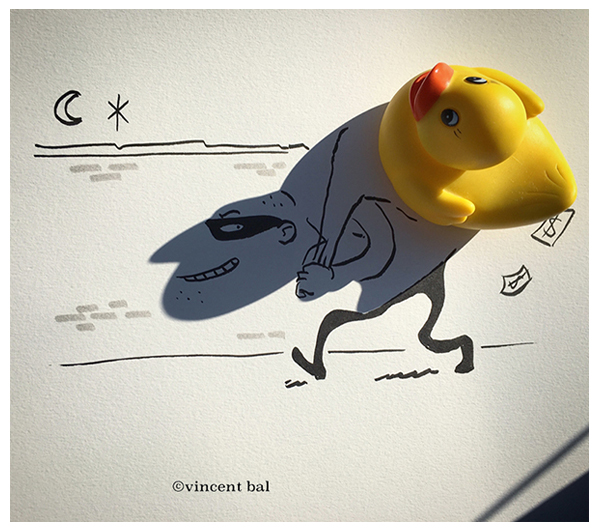
Em seu país (Bélgica) as artes sequenciais como quadrinhos e animações são muito valorizadas. O senhor poderia nos contar um pouco sobre suas influências?
Eu cresci totalmente absorvido em histórias em quadrinhos, devorei Asterix, Lucky Luke, Smurfs, Suske & Wiske, Spirou... e acho que isso é uma grande influência, não só em termos de desenho (porque são minha única educação), mas também em termos de storytelling: a maneira rápida e ágil de contar uma história através de imagens é certamente algo que aprendi lá.
Para mim, os artistas de quadrinhos são heróis tão grandes quanto os grandes diretores de cinema, ou seja, Franquin, Morris e Sempé estão lá em cima, junto com Fellini, Scorsese e Hitchcock.
(Ao final da mensagem, pedi que ele enviasse algumas ilustrações, explicando que o Brasil passa por tempos sombrios e que acreditava que sua arte pudesse ser poeticamente motivadora. As imagens desse post são as selecionadas pelo próprio artista. Obrigado, Mr. Vincent Bal!)
Acompanhe o artista Vincent Bal:
http://www.vincentbal.com
https://www.facebook.com/doodleballs/
https://www.instagram.com/vincent_bal/
….
INTERVIEW: VINCENT BAL, CREATIVITY AND SHADOWS
If you’ve ever seen the work of Vincent Bal you must have marveled at his “Shadow Doodles”. If not, this is a good opportunity to meet him and to know a little about the creative process of this respected Belgian illustrator and filmmaker who once looked differently at the shadow that a cup of tea had designed. (Ok … nothing that Gestalt hasn´t told us before, but their offspring are a mixture of singleness and wit, unique!)
A friend tagged me in one of his Facebook arts and I started to research more, devouring everything I found. I discovered your contact, I sent a message and I received the reply the next day. I translated and now I share with you. Have a good time!
Hello, Mr. Vincent Bal! (…) You tell in some interviews that your first insight happened by chance, but I confess that I doubt this “mere accident”. Is it possible to identify elements that prepared you for that very moment?
Hi, Cordeiro! (…) I am always scribbling. When I’m at a meeting, I go out with papers full of silly cartoons. Besides, I love taking pictures and I love the imagination – without imagination, the world would be such a boring place … So, in a way, I have prepared myself for these drawings all my life, but on the other hand, I strongly believe in power of coincidences, “lucky accidents” for which you have to be prepared. It’s like seeing shapes in the clouds, I think you see the shapes of the things that are on your mind. I try to get myself into a kind of semi-awake state, where fantasy and reality are close to each other. The good thing about drawing is that my hands think. I work on scripts from time to time and for this I need to think a lot rationally and structurally.
My greatest interest is to understand your creative process, but I know that this is difficult for the artist himself, since creativity is not limited to the conscious field … Whether as an illustrator or filmmaker, how could I describe the general structure of his method ? What do you cultivate and what do you despise along the way?
For me, it is very important to silence that annoying voice in my head that says, “This is not good!”. I have to work with enthusiasm, I have to have fun and in these drawings this is not so difficult, because everything is very tasty and personal and the whole team is just me and me. Working in a film is very different, it can take years from the idea to the end result and I also try to reflect on the creativity of the other collaborators. Actors, team members, songwriters, all bring something to the table that can inspire me. That way, I try to keep everything “fresh” throughout the process.
You have already stated that you are not going to the drawing board with ready ideas. However, after so many works have been done, is it even possible that you will not be tempted to “guess” what shadows things would project?
Of course I became a “shadow maniac” 🙂 Now when I see a cool shadow I always get paper and pen, but experience has taught me that the shadows are very unpredictable. There are so many elements working together, the angle of light, the distance from the source, the very precise way an object is placed. It’s all very accurate and when I try to force the shadows to be something they are not, that does not work. So, I have to let the shadows tell me what to draw and not the other way around. But of course the objects themselves inspire me and can direct my fantasy to a certain extent.
In his country (Belgium) the sequential arts like comics and animations are very valued. Could you tell us a bit about your influences?
I grew up totally absorbed in comic books, I devoured Asterix, Lucky Luke, Smurfs, Suske & Wiske, Spirou … and I think this is a big influence not only in terms of drawing (because they are my only education) but also in terms of storytelling: the quick and agile way of telling a story through images is certainly something I learned there. For me, comic artists are heroes as big as the big movie directors, that is, Franquin, Morris, and Sempé are up there, along with Fellini, Scorsese, and Hitchcock.
– At the end of the message, I asked him to send some illustrations, explaining that Brazil (my country) goes through dark times and that I believed that his art could be poetically motivating. The images in this post were selected by the artist himself. Thank you, Mr. Vincent Bal!



